Organic Soiling: The Role of Pollen in PV Module Performance Degradation
Abstract
:1. Introduction
2. Methodology
2.1. Mass Accumulation Experiment
2.2. PV Experiment
3. Annual Soiling Characterization
4. Organic Material Characterization and Features
SEM Characterization and Image Processing
5. Conclusions
Acknowledgments
Author Contributions
Conflicts of Interest
References
- Garg, H.P. Effect of dirt on transparent covers in flat-plate solar energy collectors. Sol. Energy 1974, 15, 299–302. [Google Scholar] [CrossRef]
- El-Shobokshy, M.S.; Hussein, F.M. Effect of dust with different physical properties on the performance of photovoltaic cells. Sol. Energy 1993, 51, 505–511. [Google Scholar] [CrossRef]
- Hassan, A.; Rahoma, U.A.; Elminir, H.K.; Fathy, A.M. Effect of airborne dust concentration on the performance of PV modules. J. Astron. Soc. Egypt 2005, 13, 24–38. [Google Scholar]
- Maghami, M.R.; Hizam, H.; Gomes, C.; Radzi, M.A.; Rezadad, M.I.; Hajighorbani, S. Power loss due to soiling on solar panel. Renew. Sustain. Energy Rev. 2016, 59, 1307–1316. [Google Scholar] [CrossRef]
- Conceição, R.; Silva, H.; Mirão, J.; Gostein, M.; Fialho, L.; Narvarte, L.; Collares-Pereira, M. Saharan dust transport to Europe and its impact on photovoltaic performance: A case study of soiling in Portugal. Sol. Energy 2018, 160, 94–102. [Google Scholar] [CrossRef]
- Figgis, B.; Ennaoui, A.; Ahzi, S.; Rémond, Y. Review of PV soiling particle mechanics in desert environments. Renew. Sustain. Energy Rev. 2017, 76, 872–881. [Google Scholar] [CrossRef]
- Figgis, B.; Ennaoui, A.; Guo, B.; Javed, W.; Chen, E. Outdoor soiling microscope for measuring particle deposition and resuspension. Sol. Energy 2016, 137, 158–164. [Google Scholar] [CrossRef]
- Alnaser, N.W.; Al Othman, M.J.; Dakhel, A.A.; Batarseh, I.; Lee, J.K.; Najmaii, S.; Alothman, A.; Al Shawaikh, H.; Alnaser, W.E. Comparison between performance of man-made and naturally cleaned PV panels in a middle of a desert. Renew. Sustain. Energy Rev. 2018, 82, 1048–1055. [Google Scholar] [CrossRef]
- Šúri, M.; Huld, T.A.; Dunlop, E.D.; Ossenbrink, H.A. Potential of solar electricity generation in the European Union member states and candidate countries. Sol. Energy 2007, 81, 1295–1305. [Google Scholar] [CrossRef]
- Lopes, F.; Silva, H.; Salgado, R.; Cavaco, A.; Canhoto, P.; Collares-Pereira, M. Short-term ECMWF Forecasts of Solar Irradiance for Solar Energy Systems Validated in Southern Portugal. Sol. Energy. Submitted.
- Silva, H.G.; Lopes, F.M.; Pereira, S.; Nicoll, K.; Barbosa, S.M.; Conceição, R.; Neves, S.; Harrison, R.G.; Collares Pereira, M. Saharan dust electrification perceived by a triangle of atmospheric electricity stations in Southern Portugal. J. Electrost. 2016, 84, 106–120. [Google Scholar] [CrossRef]
- Stridh, B. Evaluation of economical benefit of cleaning of soiling and snow in PV plants at three European locations. In Proceedings of the IEEE Photovoltaic Specialists Conference, Austin, TX, USA, 3–8 June 2012; pp. 1448–1451. [Google Scholar]
- Appels, R.; Lefevre, B.; Herteleer, B.; Goverde, H.; Beerten, A.; Paesen, R.; De Medts, K.; Driesen, J.; Poortmans, J. Effect of soiling on photovoltaic modules. Sol. Energy 2013, 96, 283–291. [Google Scholar] [CrossRef]
- Naeem, M.; Tamizhmani, G. Climatological relevance to the soiling loss of photovoltaic modules. In Proceedings of the 2015 Saudi Arabia Smart Grid, Jeddah, Saudi Arabia, 7–9 Dcember 2016; pp. 1–5. [Google Scholar]
- Aïssa, B.; Isaifan, R.J.; Madhavan, V.E.; Abdallah, A.A. Structural and physical properties of the dust particles in Qatar and their influence on the PV panel performance. Sci. Rep. 2016, 6, 1–12. [Google Scholar] [CrossRef] [PubMed]
- Olivares, D.; Ferrada, P.; Matos, C.D.; Marzo, A.; Cabrera, E.; Portillo, C.; Llanos, J. Characterization of soiling on PV modules in the Atacama Desert. Energy Procedia 2017, 124, 547–553. [Google Scholar] [CrossRef]
- Caeiro, E.; Brandão, R.; Carmo, S.; Lopes, L.; de Almeida, M.M.; Gaspar, Â.; Oliveira, J.F.; Todo-Bom, A.; Leitã, T.; Nunes, C. Rede Portuguesa de Aerobiologia: Resultados da monitorização do pólen. Rev Port Imunoalergologia 2007, 15, 235–250. [Google Scholar]
- Hamaoui-Laguel, L.; Vautard, R.; Liu, L.; Solmon, F.; Viovy, N.; Khvorostyanov, D.; Essl, F.; Chuine, I.; Colette, A.; Semenov, M.A.; et al. Effects of climate change and seed dispersal on airborne ragweed pollen loads in Europe. Nat. Clim. Chang. 2015, 5, 766–771. [Google Scholar] [CrossRef]
- Elminir, H.K.; Ghitas, A.E.; Hamid, R.H.; El-Hussainy, F.; Beheary, M.M.; Abdel-Moneim, K.M. Effect of dust on the transparent cover of solar collectors. Energy Convers. Manag. 2006, 47, 3192–3203. [Google Scholar] [CrossRef]
- Gostein, M.; Duster, T.; Thuman, C. Accurately measuring PV soiling losses with soiling station employing module power measurements. In Proceedings of the 2015 IEEE 42nd hotovoltaic Specialists Conference, New Orleans, LA, USA, 14–19 June 2015; pp. 3–7. [Google Scholar]
- Dunn, L.; Littmann, B.; Caron, J.R.; Gostein, M. PV module soiling measurement uncertainty analysis. In Proceedings of the 2013 IEEE 39th Photovoltaic Specialists Conference, Tampa, FL, USA, 16–21 June 2013; pp. 658–663. [Google Scholar]
- Todo-bom, A.; Brandão, R.; Nunes, C.; Caeiro, E.; Leitão, T.; Oliveira, J.F.; de Almeida, M.M. Allergenic airborne pollen in Portugal 2002–2004. Rev Port Imunoalergologia 2006, 14, 41–49. [Google Scholar]
- Alcázar, P.; Galán, C.; Cariñanos, P.; Domínguez-Vilches, E. Diurnal variation of airborne pollen at two different heights. J. Investig. Allergol. Clin. Immunol. 1999, 9, 89–95. [Google Scholar] [PubMed]
- Grewling, L.; Bogawski, P.; Smith, M. Pollen nightmare: Elevated airborne pollen levels at night. Aerobiologia 2016, 32, 725–728. [Google Scholar] [CrossRef] [PubMed]
- Marques, G.; Martins, C.; Belo, J.; Alves, C.; Paiva, M.; Caeiro, E.; Leiria-Pinto, P. Pollen Counts Influence Web Searches for Asthma and Rhinitis. J. Investig. Allergol. Clin. Immunol. 2016, 26, 192–194. [Google Scholar]
- Albertine, J.M.; Manning, W.J.; Da Costa, M.; Stinson, K.A.; Muilenberg, M.L.; Rogers, C.A. Projected carbon dioxide to increase grass pollen and allergen exposure despite higher ozone levels. PLoS ONE 2014, 9, 1–6. [Google Scholar] [CrossRef] [PubMed] [Green Version]
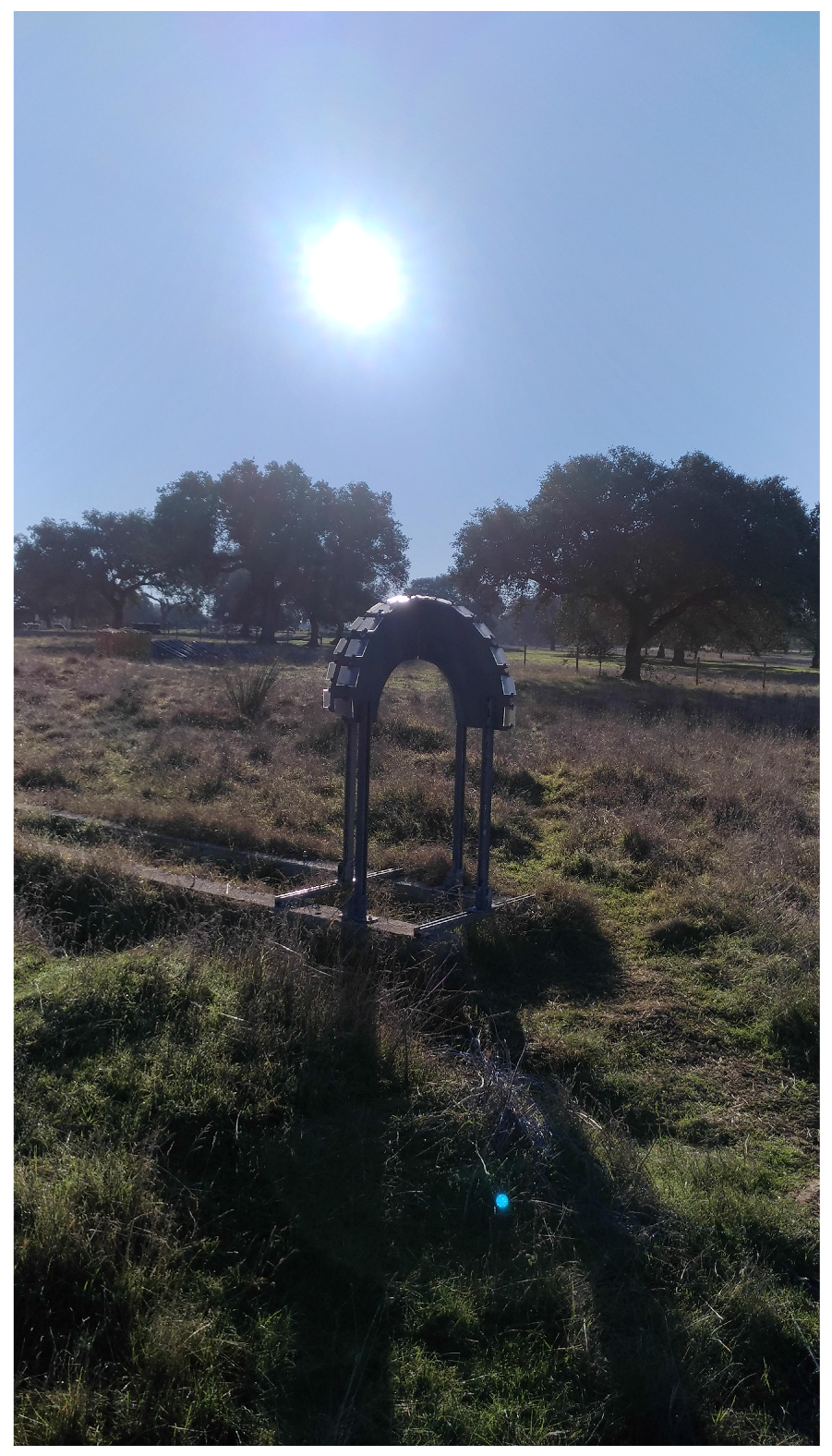
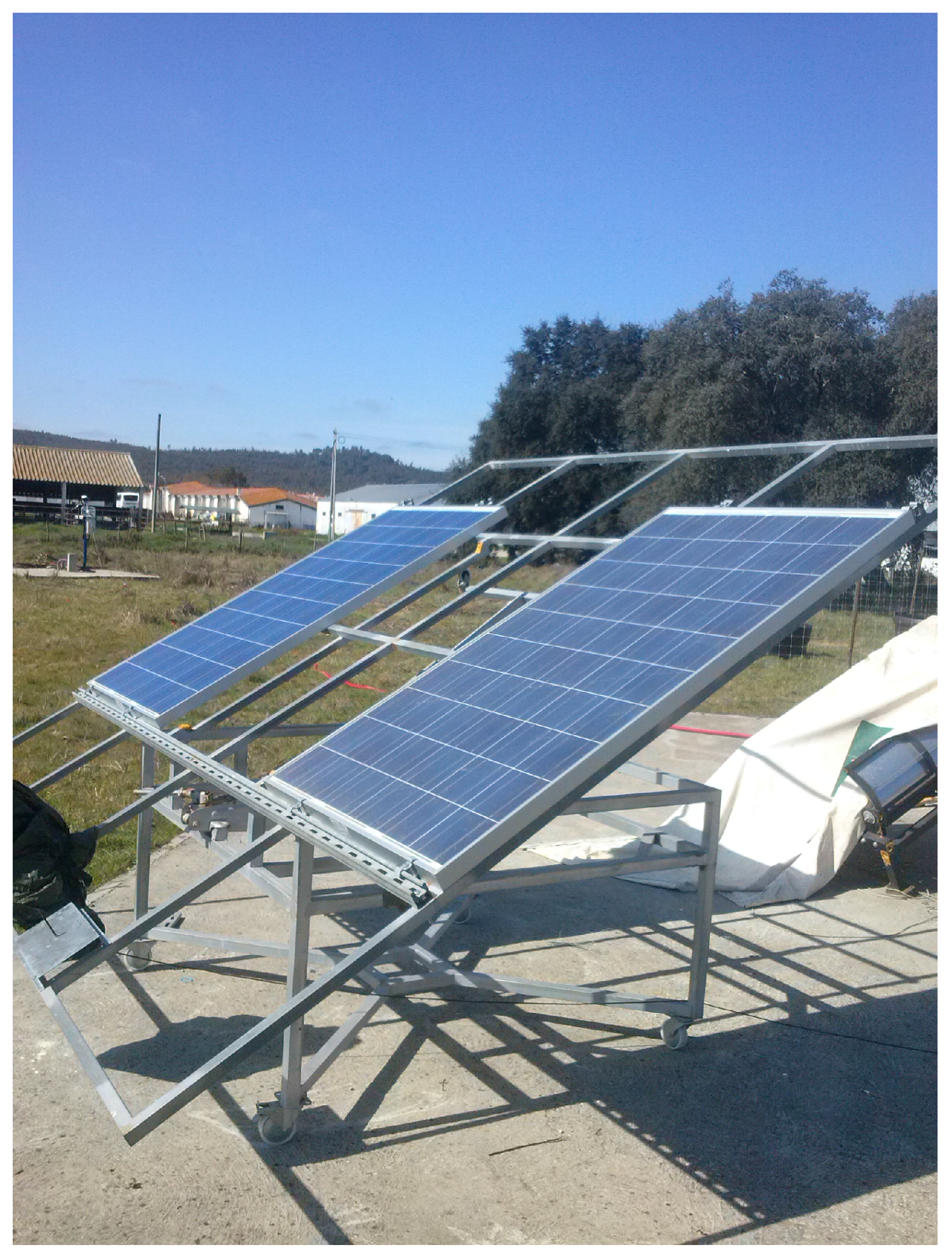
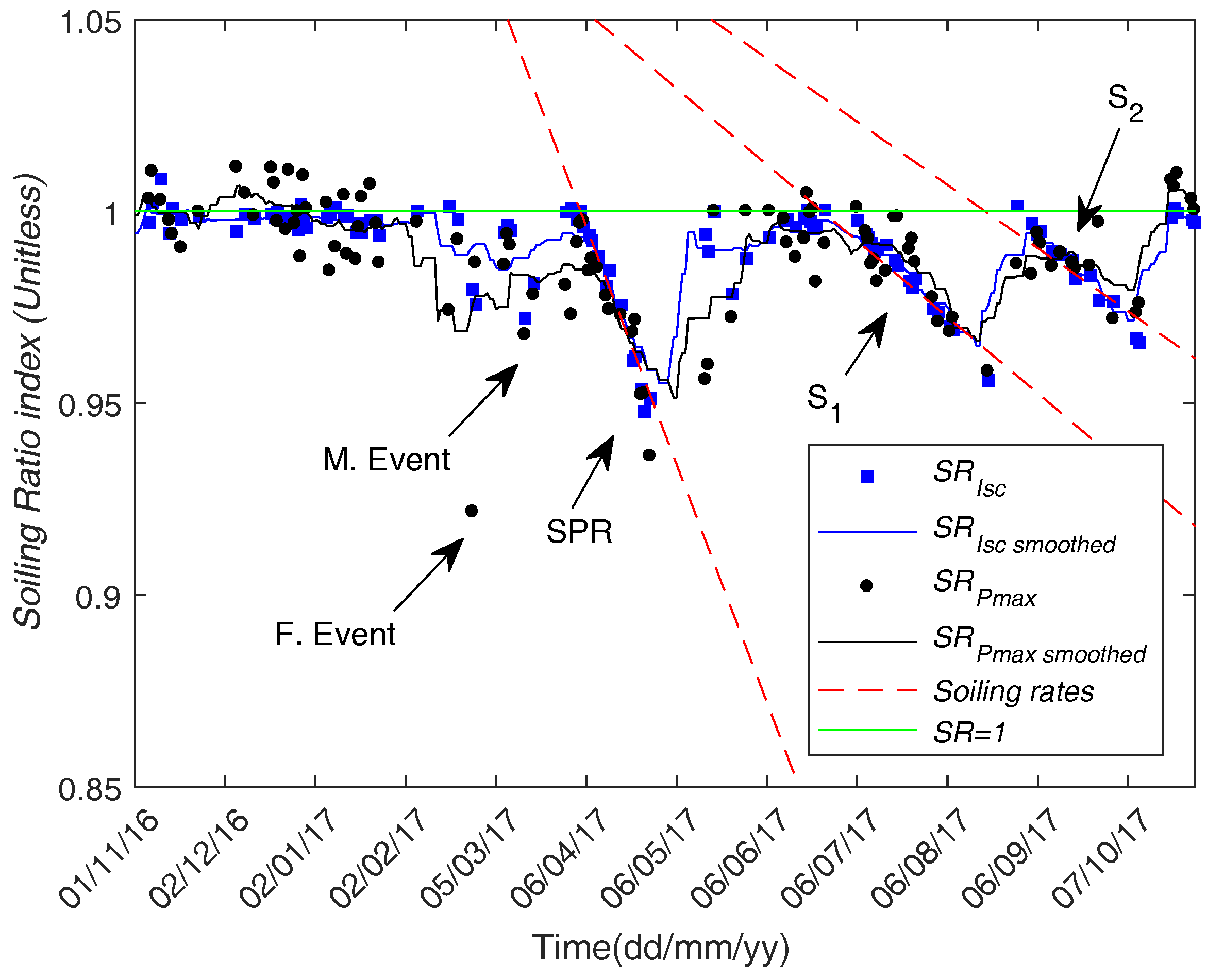
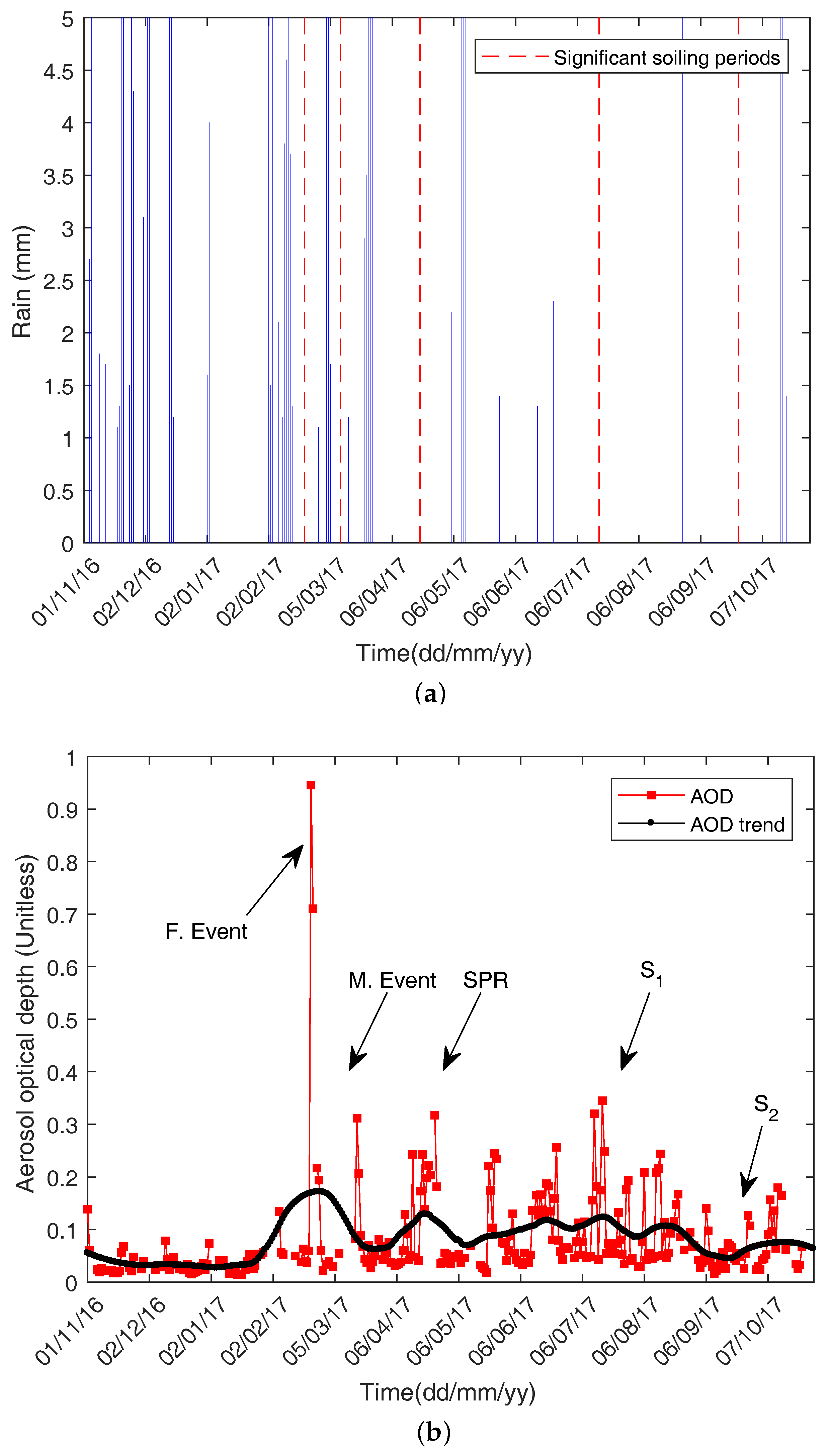
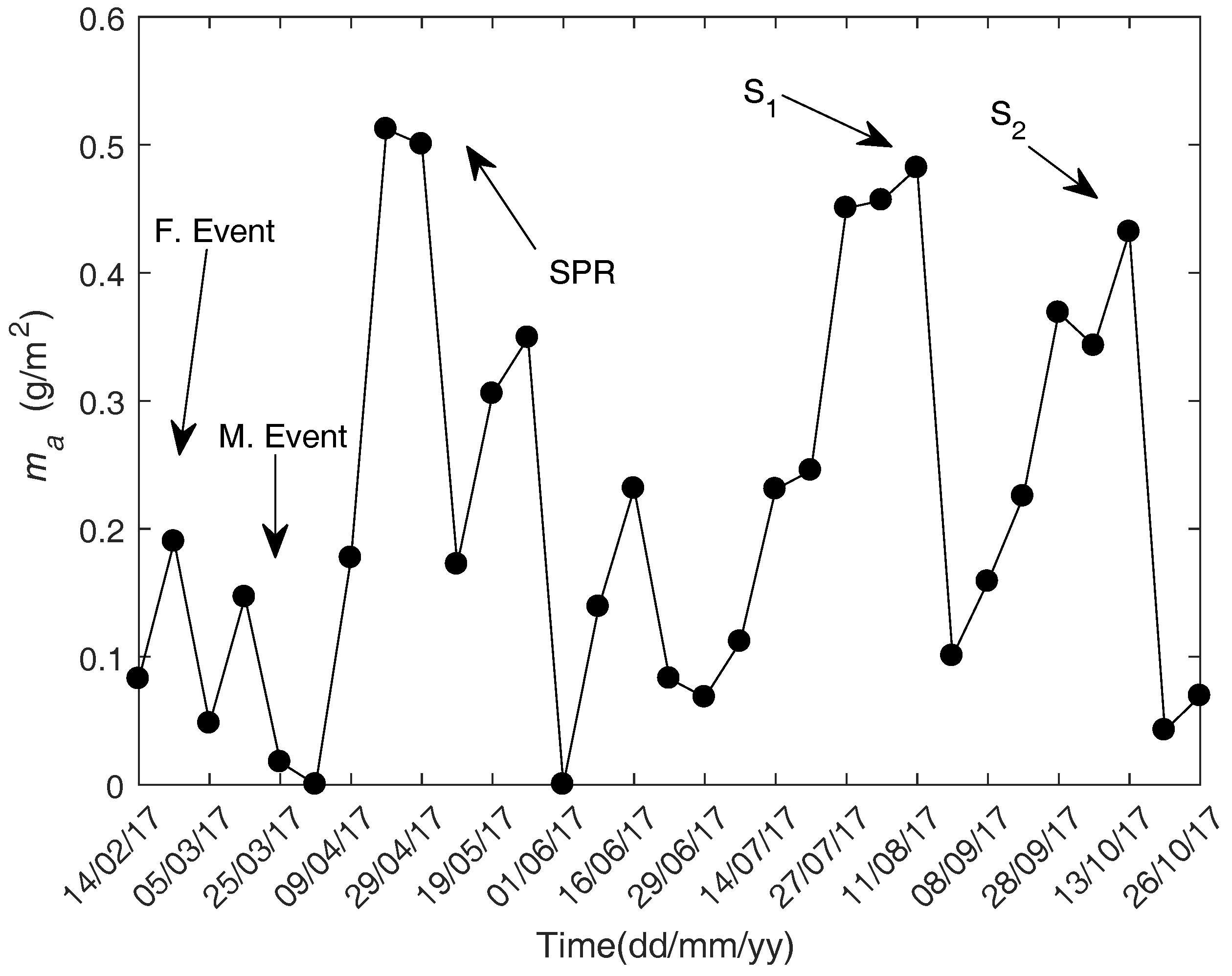
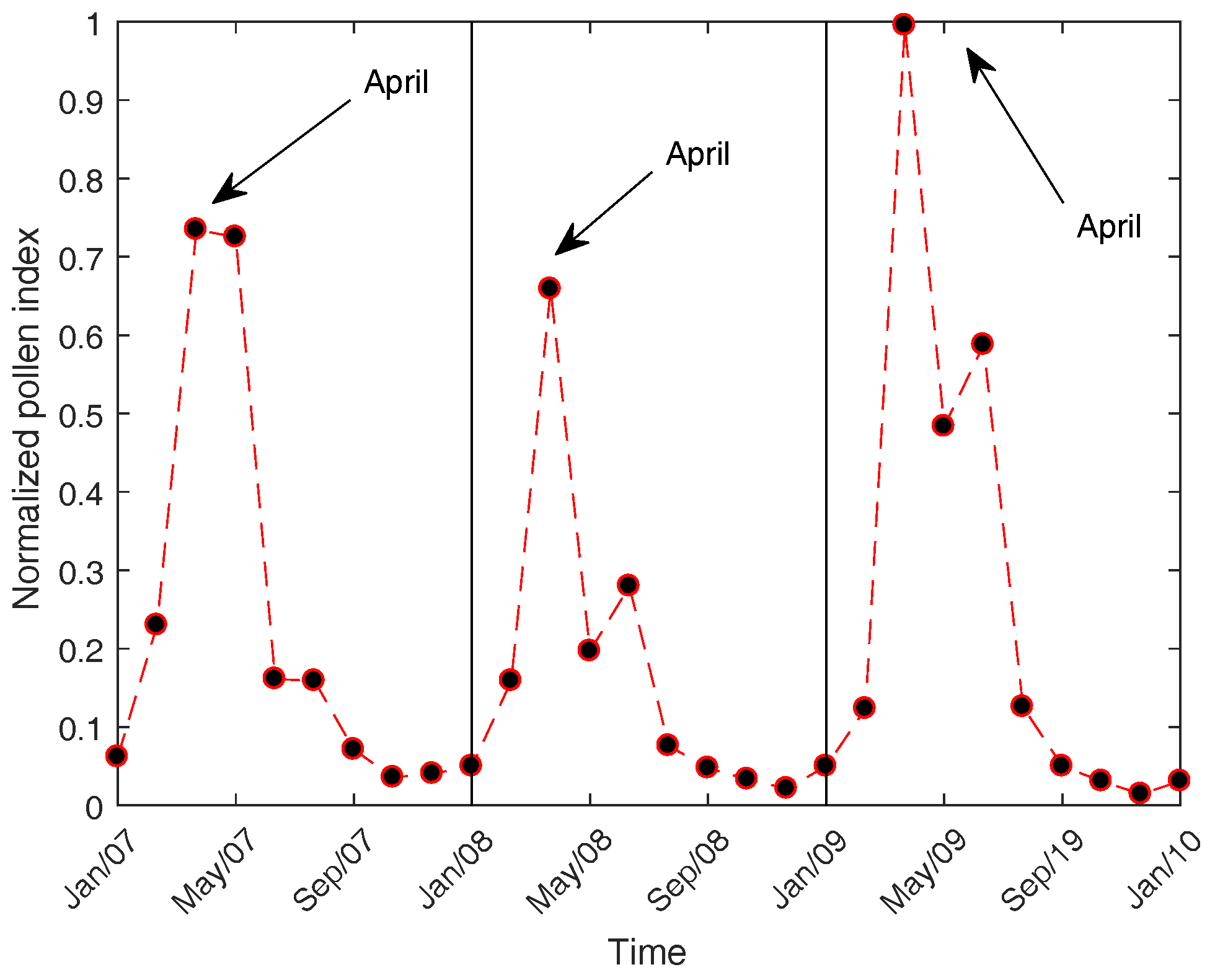
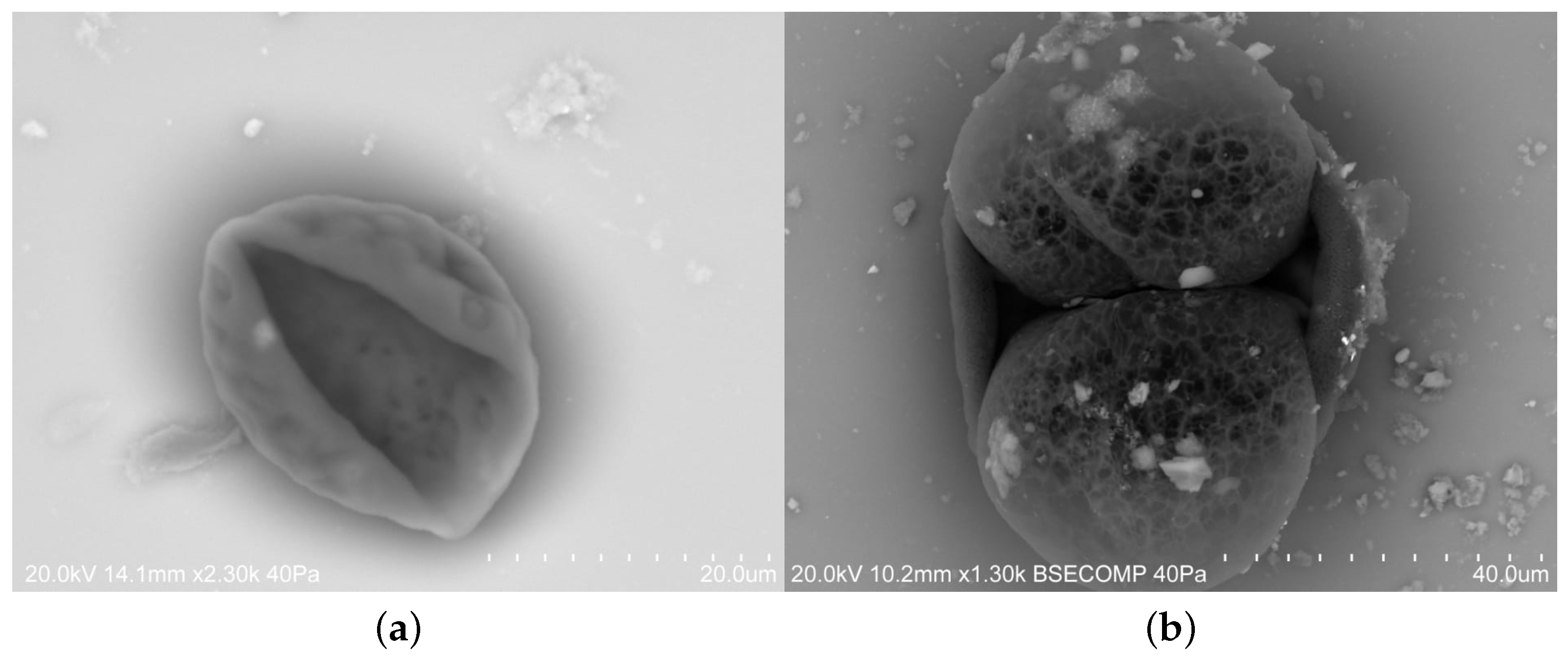
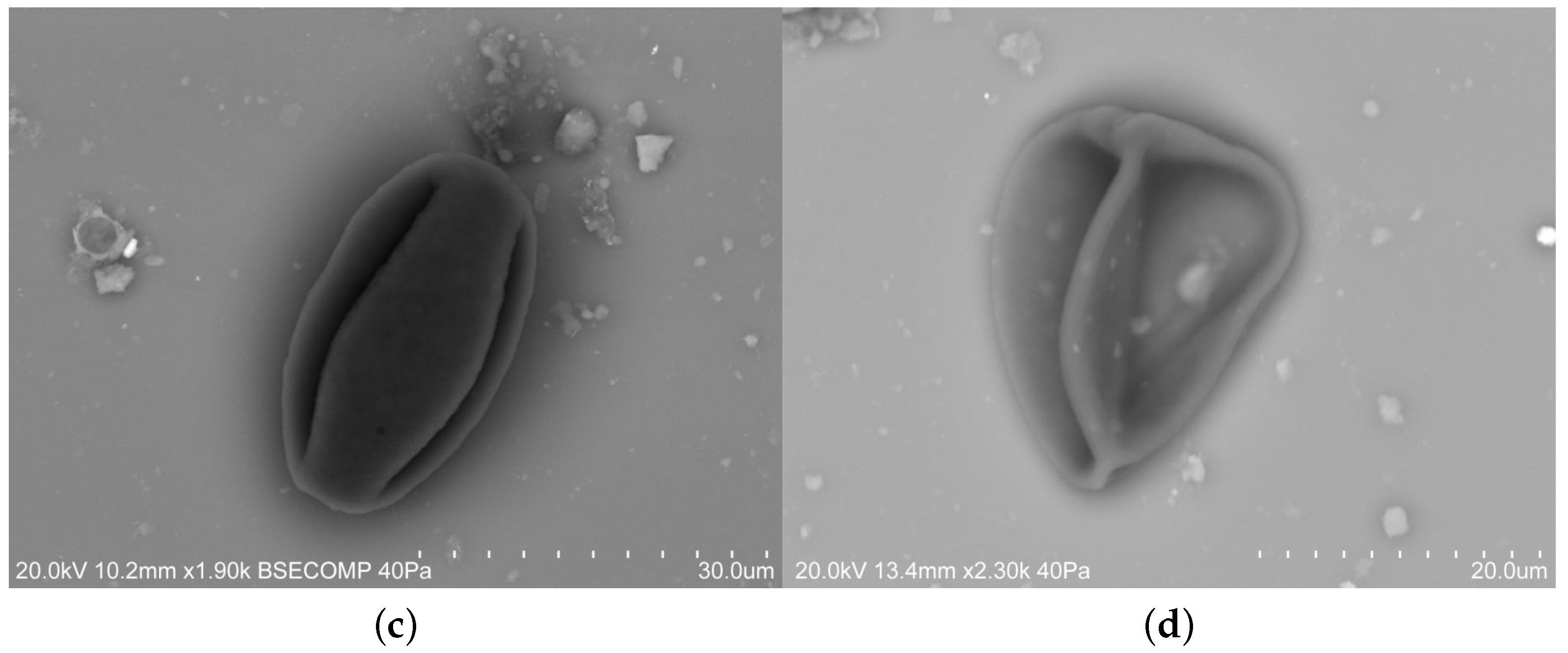
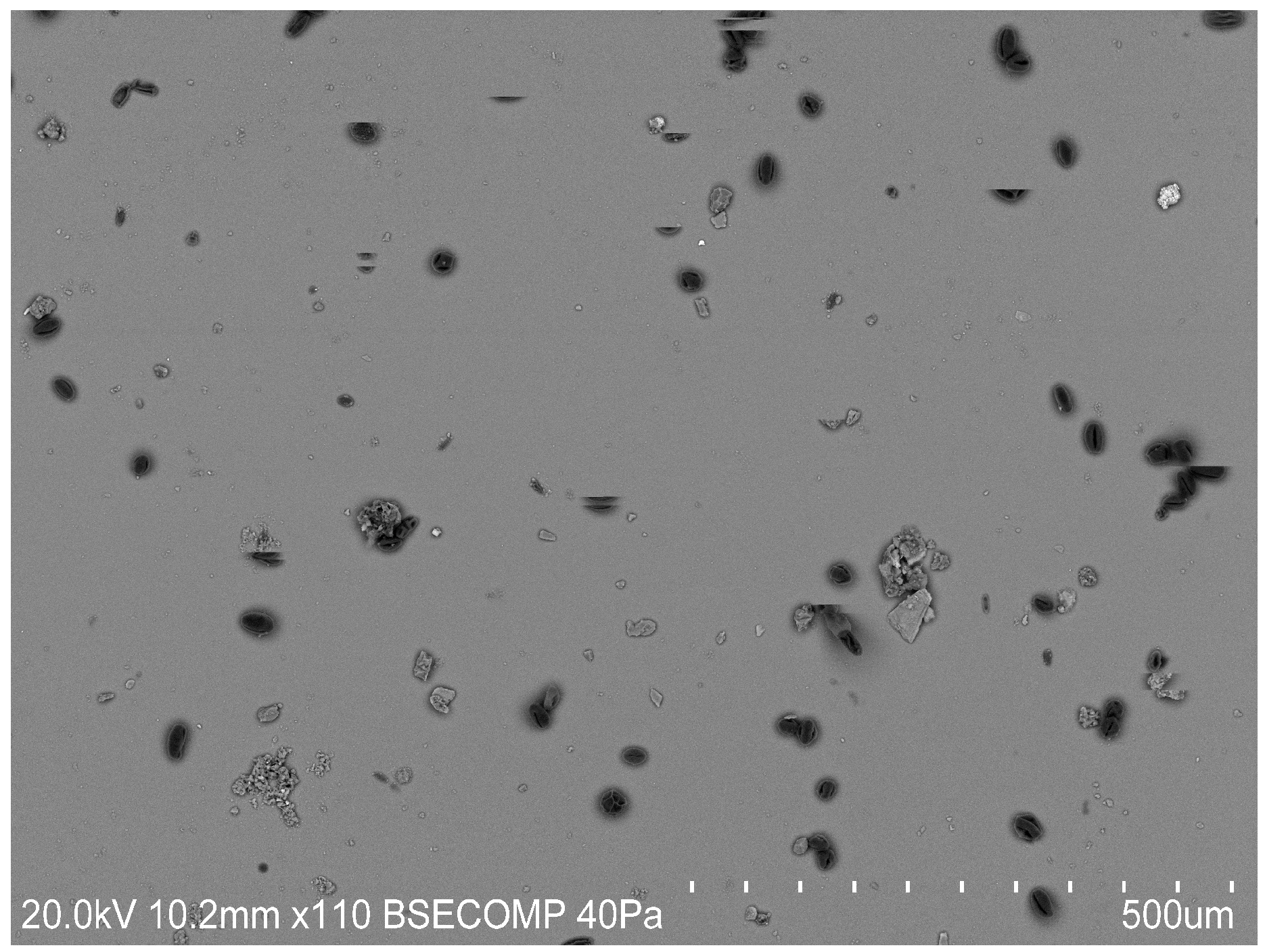
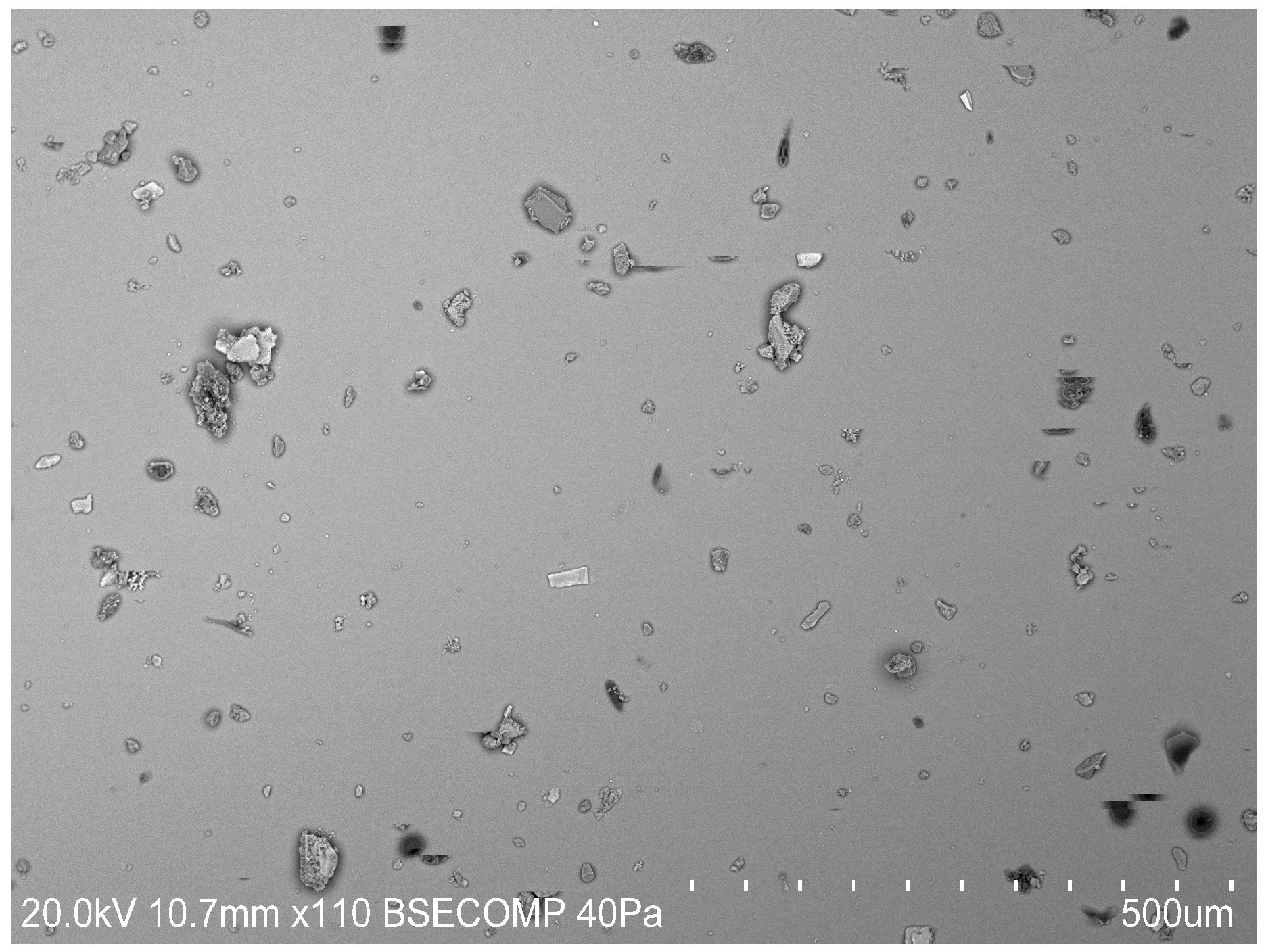
| Indicators | SPR | S1 | S2 |
|---|---|---|---|
| (%/month) | 4.1 | 1.9 | 1.6 |
| 0.97 | 0.97 | 0.94 | |
| RMSE | 0.0013 | 0.0007 | 0.0008 |
| Parameters | April | July |
|---|---|---|
| () | 20.5 | 19.3 |
| () | 14.4 | 14.9 |
| (%) | 33.8 | 4.1 |
| (%) | 40.3 | 6.5 |
© 2018 by the authors. Licensee MDPI, Basel, Switzerland. This article is an open access article distributed under the terms and conditions of the Creative Commons Attribution (CC BY) license (http://creativecommons.org/licenses/by/4.0/).
Share and Cite
Conceição, R.; Silva, H.G.; Mirão, J.; Collares-Pereira, M. Organic Soiling: The Role of Pollen in PV Module Performance Degradation. Energies 2018, 11, 294. https://doi.org/10.3390/en11020294
Conceição R, Silva HG, Mirão J, Collares-Pereira M. Organic Soiling: The Role of Pollen in PV Module Performance Degradation. Energies. 2018; 11(2):294. https://doi.org/10.3390/en11020294
Chicago/Turabian StyleConceição, Ricardo, Hugo G. Silva, José Mirão, and Manuel Collares-Pereira. 2018. "Organic Soiling: The Role of Pollen in PV Module Performance Degradation" Energies 11, no. 2: 294. https://doi.org/10.3390/en11020294





